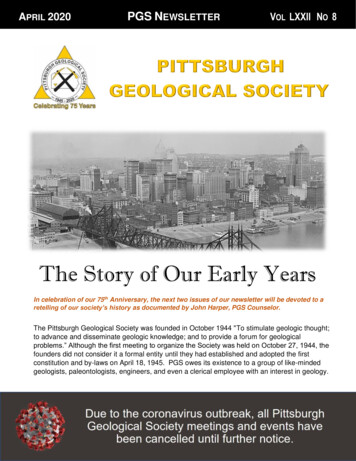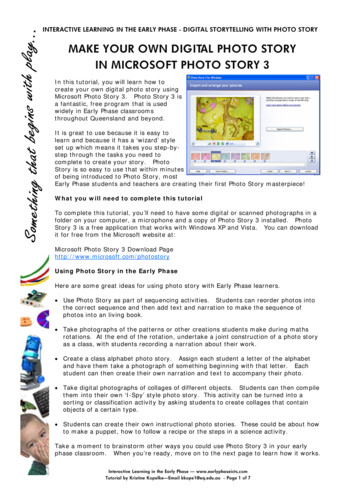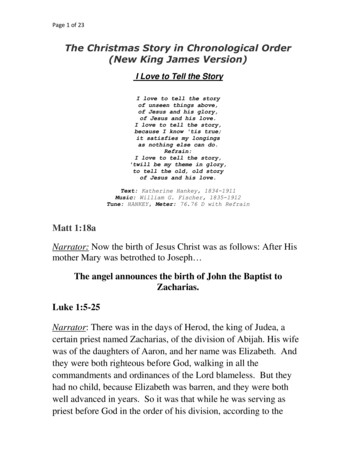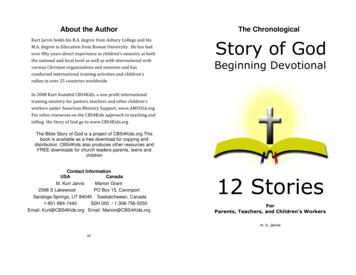
Transcription
APRIL 2020PGS NEWSLETTERVOL LXXII NO 8The Story of Our Early YearsIn celebration of our 75th Anniversary, the next two issues of our newsletter will be devoted to aretelling of our society’s history as documented by John Harper, PGS Counselor.The Pittsburgh Geological Society was founded in October 1944 "To stimulate geologic thought;to advance and disseminate geologic knowledge; and to provide a forum for geologicalproblems.” Although the first meeting to organize the Society was held on October 27, 1944, thefounders did not consider it a formal entity until they had established and adopted the firstconstitution and by-laws on April 18, 1945. PGS owes its existence to a group of like-mindedgeologists, paleontologists, engineers, and even a clerical employee with an interest in geology.
The following is a list of the founders and their affiliations in 1944-1945.Edith I. Baum, Secretary, Huntley & Huntley, Inc.Robert E. Bayles, Geologist, Peoples Natural GasRaymond E. Birch, Research Engineer, Harbison-WalkerRefractories CompanyHugh R. Brankstone, Geologist, Gulf Oil CorporationDaniel A. Busch, Geologist, Huntley & Huntley, Inc.Charles H. Feldmiller, Geologist, Equitable Gas CompanyCharles R. Fettke, Professor of Geology, Carnegie Instituteof TechnologyRichard M. Foose, Geologist, Pennsylvania GeologicalSurveyJane Freedman, Vertebrate Paleontologist, CarnegieMuseumJohn T. Galey, Independent Oil and Gas ProducerSidney S. Galpin, Geologist, Peoples Natural GasCompanyJohn V. GoodmanGeorge C. Grow, Geologist, Peoples Natural GasCompanyL. Guy Huntley, Geologist, Huntley & Huntley, Inc.F. Arthur Johnson, Independent Oil and Gas ProducerJ. LeRoy Kay, Vertebrate Paleontologist, CarnegieMuseumDavid K. Kirk, Geophysicist, Gulf Research &Development CompanyJames H. C. Martens, Mineralogist, West VirginiaGeological SurveyShailer S. Philbrick, Geologist, U.S. Army Corps ofEngineersFrank W. Preston, Glass Technologist and Owner, PrestonLaboratoryW. Bernard Robinson, Geophysicist, Gulf Research &Development CompanyRichard E. Sherrill, Professor of Geology and DepartmentHead, University of Pittsburgh,James F. Swain, Geologist and Partner, Huntley &Huntley, Inc.Dana Wells, Associate Professor of Geology, WestVirginia UniversityPGS’s first officers, clockwise from top left,President George C. Grow, Jr., Vice PresidentRaymond E. Birch, Secretary W. BernardRobinson, and Treasurer Dr. Shailer S. Philbrick.PGS was a welcoming society from the beginning.Despite its elite-sounding scientific objectives, theSociety encouraged anyone interested in geology andthe earth sciences to join and become activeparticipants in the membership. Many of the industriesconcentrated in the Pittsburgh area maintained activegeological research and exploration in oil and gas,coal, iron and steel, aluminum, ceramics, glass, andothers. In addition, the University of Pittsburgh,Carnegie Institute of Technology, and the CarnegieMuseum of Natural History had active geologists andpaleontologists on staff, some of whom were foundingmembers. Initially, the founders had hoped to recruitabout 40 members from this diverse community ofindustries, academe, and science, but it immediately began to grow beyond leaps andbounds. By the end of its first program year (1944-1945), PGS had a total paid membershipof 172 from nine states, consisting of everyone from geologists with Ph.D. degrees and/ordecades of professional experience to students and those interested in geology as a hobby.When PGS was formalized, the Constitution provided for the selection of four officers whowere part of the governing Council. During the first full program year, 1945-1946, George C.2
Grow, Jr. served as President, Raymond E. Birch was Vice President, W. Bernard Robinsonwas Secretary, and Dr. Shailer S. Philbrick was Treasurer. Other Councilors included RobertE. Bayles, Hugh R. Brankstone, C. H. Feldmiller, Richard M. Foose, John T. Galey, David K.Kirk, and James H. C. Martens. L. Guy Huntley was the editor of the Society’s newsletter,called Pittsburgh Geologist, which was printed on various colored papers on a mimeographmachine.The early Society had three classes of membership: Member (for professional geologists andengineers, with “Charter Member” reserved for the founders), Associate Member (forinterested lay persons), and Student Member. With the exception of students, all memberswere eligible to vote but only Members could run for office or other Council positions. In 1948,annual membership dues included 5.00 for Members (there were 160 in 1948) andAssociate Members (16), and 1.00 for Student Members (10). In celebration of the 25thAnniversary of PGS in 1970, those Charter Members (the Founders) of the Society who hadmaintained membership through the years were named as Honorary Life Members. Eighteenof the original 24 received this honor.From the beginning, PGS has limited itsannual meetings to nine, Septemberthrough the following May (except for thevery first year; the Society did not exist inSeptember 1944). Summer months werereserved for fieldwork. The Society’smonthly meetings were a majorcontributing factor in PGS’s growth,following the principle that speakersshould be among the best in their field,and their subjects must be of interest toall. Although many of the foundersworked in the petroleum industry andsought, successfully, to become affiliatedwith the American Association ofPetroleum Geologists (AAPG), petroleumgeology did not dominate Societyprograms. No single geologic disciplinereceived priority over any other. GeologyMany of the speakers during the Society’s firstand geology-related topics of all10 years included famous geologists such as,disciplines were presented by a host ofclockwise from top left, Ernst Cloos, Richardspeakers, many of whom were nationallyFoster Flint, M. King Hubbert, George GaylordSimpson, W. H. Twenhofel, and J. Tuzo Wilson.or even internationally known and wouldcome to be included in the pantheon of20th century American geologists. These included the likes of Marland P. Billings, ErnstCloos, Robert H. Dott, Maurice Ewing, Richard Foster Flint, M. King Hubbert, Philip B. King,W. C. Krumbein, A. I. Levorsen, W. W. Rubey, Francis P. Shepard, George GaylordSimpson, Lawrence L. Sloss, W. H. Twenhofel, and J. Tuzo Wilson, just to name a few. Thisenabled the Society to attract membership from a broad range of specialties across westernPennsylvania and adjacent states. PGS meetings gave individuals not only an opportunity to3
hear many diverse subjects but also to network with others interested in geologically-relatedsubjects. Meetings offered the chance to become acquainted with other members, to discusstopics of interest, and to find out what others were doing and what they might havediscovered. Attendance at meetings during the first years averaged more than a hundredpersons, with attendees drawn from Ohio and West Virginia as well as from throughoutwestern Pennsylvania. PGS meetings were held in downtown Pittsburgh at the William PennHotel (now called the Omni William Penn) and the former Fort Pitt Hotel (which stood at theintersection of Penn Avenue and Tenth Street where the Westin Pittsburgh, adjacent to theDavid L. Lawrence Convention Center, now stands), and in Oakland at the Mellon Institute(now part of Carnegie Mellon University).PGS also began early to be involved in organizing and leading field trips, symposia, andother special events. In November1946, the Council extended an invitationto AAPG to hold a regional meeting inPittsburgh in October 1947 that wouldinclude three days of meetings and aone-day field trip. Although the meetinglasted only one day and had no relatedfield trip, the invitation resulted in ASymposium on the Ordovician of theAppalachian Basin held on May 16,1947, with presented papers publishedin 1948 in the AAPG Bulletin, v. 32, no.8, p. 1395-1657.On October 4-9, 1948, PGS hosted theAAPG Mid-Year Meeting at the WilliamPenn Hotel with an attendance of almost300. Ninety-seven people in threeGreyhound buses attended the meetingfield trip, led by Penn State ProfessorFrank M. Swartz (see map, right). In1950, PGS co-hosted and co-led the16th Annual Field Conference ofField trip route map for the first field tripPennsylvania Geologists with thehosted by PGS, for the 1948 AAPG MidyearUniversity of Pittsburgh, and five yearsMeeting in Pittsburgh. The field trip waslater hosted Appalachian Geology,led by Dr. Frank M. Swartz of Penn State.Pittsburgh to New York, a field trip heldin conjunction with the annual meeting ofAAPG in New York City. (All of these guidebooks can be downloaded from the PGS s-field-guides.html)PGS got off to a great start and has never looked back. In its 75 years of existence, theSociety has continued to provide services and superior programs to its membership and tothe geological community of western Pennsylvania.4
PRESIDENT’S STATEMENTSince viruses do not survive outside of a host celland are not preserved in the fossil record, whatdo we know about their evolutionary history?Viruses have a rapid mutation rate and evolvewhen there is change to their RNA or DNAsequence upon interaction with the host cell.Because of their high mutation rate virusesquickly adapt to changes in their hostenvironment and pass these mutations on to theoffspring. The best adapted mutants will quicklyoutnumber their less fit counterparts, following theDarwinian evolution premise. One group ofviruses that paleovirologists study is theretroviruses. A retrovirus is a type of RNA virusthat inserts a copy of its genome into the DNA ofthe host cell changing the genome of that cell.This change in the genome can be passed on tothe next generation and potentially preserved inthe genome of the host population. Essentially,paleovirologists investigate viral fossils that arenot mineralized but are pieces of genetic codeheld over in the genome of modern animals.The world is battling apandemic and most of theU.S. is under a stay athome order as we try tostop the spread of thecontagion COVID 19.College campuses andother educationalinstitutions have taken tothe virtual space and most professionals areworking remotely. This is new territory for many,learning new ways to communicate, gaining newtechnical skills and developing better timemanagement skills as they balance work,childcare, and home schooling. For manygeologists, the work is divided between field andoffice/lab work. For now, the individuals with officework are not being impacted, but those who arefield technicians may be waiting until they canresume working, or they are risking their health inorder to complete their jobs.The hardest part of all is not being able to see theenemy leading to a fear of the unknown. Peopleare afraid to go outside for fear they may becomeinfected or become a vector and in return infectsomeone else. What is it that we are trying toavoid? They call it COVID 19, a single strandedRNA virus that can cause severe respiratorysymptoms. What are viruses really? Do viruseshave an evolutionary history? Could a viralinfection have played a role in mass extinctions?It turns out that viruses leave no physical fossilrecord since they only persist for short periods oftime and commonly degrade quickly, leaving nodirect trace of their existence. However,paleovirologists have identified a genetic fossilrecord of extinct viruses that are preserved in thegenomes of modern organisms. This piqued myinterest while staying at home trying to find somerelative information for my paleo class. So here isa synopsis of what I found.The genomes of most vertebrate species containsequences derived from ancient retroviruses andare used as evidence for the understanding theirevolutionary history. For example, paleovirologistshave discovered hepadnavirus (a virus group thatincludes hepatitis B) hiding in the genomes ofmodern songbirds. The researchers traced thecommon ancestors of these birds and haveestimated that this family of viruses has beenaround for at least 19 million years—and possibly40 million years (Gilbert and Feschotte, 2010). Isit possible to use the modern genome todetermine if viruses and other diseases wereresponsible for extinction events of the past, forexample the End-Cretaceous mass extinction?Unfortunately, this is highly unlikely. A virus willcause disease only in one species or in a group ofrelated species. Therefore, even if there was avirus that infected and killed off multiple speciesof dinosaurs, it would not have infected theammonites, or marine reptiles, or flying reptilestoo.Let’s start with the definition of a virus fromMerriam Webster. Virus is any large group ofsubmicroscopic infectious agents, ranging in sizefrom 20 to 400 nanometers. Viruses are vesselsof nucleic acid, either DNA or RNA, surroundedby a semipermeable protein (or lipid) membrane.On a side note, health officials tell everyone towash your hands with soap and water. This isimportant because soap will destroy thissemipermeable membrane killing off the virus.These vessels are only capable of growth andmultiplication once they have entered a host cell.Outside a living cell, a virus is dormant or may notsurvive, because it lacks the materials needed forreproduction. Once inside a living cell it uses thecell’s metabolism to reproduce. Viruses haveshort generation times, and some have highmutation rates, meaning once they enter thegenome in the host cell, they change rapidly.As always, I want to thank our corporate sponsorsand the membership for your constant supportand understanding during this difficult time. Wewill keep you updated through April to the statusof the May meeting and look forward to gettingtogether to celebrate the return to some normalcy.Please stay safe from the COVID-19.TamraReference: Gilbert C, and Feschotte C. 2010,Genomic fossils calibrate the long-term evolution ofhepadnaviruses. PLoS Biology, v. 8, 2946954/5
PGS 75th ANNIVERSARYFIELD TRIPSIn celebration of the founding of PGS in 1945, the PGS 75th Anniversary Committeeis pleased to offer two or, possibly, three field trips during our anniversary year.The first field trip will take place on Saturday,March 28, 2020 when Dr. James V. Hamel, longtime Honorary Member and consulting geologistand engineer, will lead us on a trek to examinelandslides along I-79 north (or northwest) ofPittsburgh between the Ohio River/GlenfieldBorough area and the Mt. Nebo exit. Jim spoke ofhis history with these landslides at the January2020 meeting held jointly with the ASCE GeoInstitute and AEG. In addition to the I-79 slides,we will be investigating slides on the nearbyLandslide featuresWestern Pennsylvania Conservancy propertynorth of Pittsburghalong Toms Run Road and discuss KilbuckTownship’s infamous Walmart slide along PARoute 65. Early registration will open on the PGS website on February 15. The early bird price will be 40 ( 20 for students) until March 14. If any spots remain open, the price will rise to 45 ( 25 forstudents) until the final closing date of March 23, 2020. This trip will be limited to 40 participants.On Saturday, September 19, 2020, Albert Kollar willtake us on a journey from the Carnegie Museumthrough Schenley and Frick Parks and the easternPittsburgh suburbs to the Braddock/East Pittsburgharea to discover the Geology, History, Energy andIndustry that made Pittsburgh great. A detaileditinerary of this field trip along with photos of theplanned stops can be found on the following page.Conemaugh Groupstratigraphy, Pitcairn, PA.Outcrops along theGreat Allegheny PassageA possible third field trip to examine the geologyand history of the Great Allegheny Passage rail trailsouth of Pittsburgh is being considered for sometime during the summer months. Stay tuned to thePGS newsletters, email announcements and thewebsite for more information concerning this trip.6
PGS 75th ANNIVERSITY FALL FIELD TRIP PITTSBURGH EASTGEOLOGY, HISTORY, ENERGY, AND INDUSTRY THAT MADE PITTSBURGH GREAT19 September 20208 AM – 4:45 PMLeader Albert D. KollarStop 1: Carnegie Museum Parking Lot: Carnegie Museum, University of Pittsburgh, Carnegie Mellon University,Geology of Oakland, John Kane Landscape Painting - Cultural and Education Center of Pittsburgh.Stop 2: Schenley Park: George Westinghouse Memorial - Industry.Stop 3: Calvary Cemetery: Appalachian Plateau Geology, Monongahela River Valley, John Kane Landscape Painting –Geology and Industry.Stop 3a: Squirrel Hill: “Summerset at Frick Park” Slag Dump - Industry.Stop 4: Frick Park: Pre-Pleistocene Geology, Landslides, Fern Hollow Trail, Conemaugh Group Geology, Nine Mile RunGas Belt – Geology - Energy.Stop 5: Lunch. Frick Park Environmental Center. Modern restrooms.Stop 6: North Braddock: Braddock’s Battlefield History Center - French and Indian War History c. 1755, GeorgeWashington Monument - History.Stop 6a: Braddock: Braddock Carnegie Library open in 1889 was Andrew Carnegie’s first library in U.S. The libraryexpanded in 1893 - Architecture.Stop 7: Braddock: Edgar Thomson Plant, first Carnegie Steel 1875 – Industry.Stop 8: East Pittsburgh, PA: George Westinghouse Memorial Bridge built 1932, John Kane’s Turtle Creek Valley No. 1circa 1930, and George Westinghouse Electric Company East Pittsburgh Plant open 1886 – Industry andtransportation.Stop 9: East Pittsburgh, PA: 2018 Landslide of Rte. 30 – Geohazard.End of field trip return to Carnegie Museum.7
The Pittsburgh Geological Society is proud to announceThe Frank BenacquistaUndergraduate ScholarshipThe PGS Frank Benacquista Undergraduate Scholarship is an award of 500to an undergraduate earth science student. This scholarship, created in honorof a long-time PGS member and student advocate, is intended to assist astudent with college education costs and to promote student participation in thePittsburgh Geological Society. Submissions will be judged based on coverletter, recommendation letter, transcript, and the content and creativity of theessay as determined by the Scholarship Committee.Eligibility Requirements and Acceptable Use of FundsAny student who is majoring in the earth sciences, is at least a sophomore, and attending a four-yearaccredited college or university in the Pittsburgh region is eligible to apply. The applicant must be a studentmember of PGS or must have applied for student membership at the time of application for the scholarship.Students may use the scholarship toward tuition fees, for field camp, to purchase equipment required forgeologic course work or research (e.g., rock hammers, hand lens), to attend geologic conferences or fieldtrips, such as a school-sponsored trip, a PGS field trip or the Field Conference of Pennsylvania Geologists.Required Materials One-page resumeCover letter introducing yourself with a focus on activities outside of the classroom such as research projects,academic club service, or community involvementOne-page essay describing your background, decision to pursue earth science, career goals, and academicobjectives beyond the bachelor’s degree (if any)Copy of your transcript (unofficial) and documentation that you are a current student. The requisite standard toapply is a minimum of 12 semester credits of earth science courses. Successful applicants should have astrong academic record in course work, research or serviceLetter of recommendation from a professor or another professional in the earth science field that providesinformation on your performance and activities in the classroom, in the department, or elsewhere. The lettershould address your work ethic and your character in how you work and assist others in the classroom or field.Scholarship Application ProcessYour application may be printed and submitted by mail to: Pittsburgh Geological SocietyAttn: Scholarship CommitteeP.O. Box 58172 Pittsburgh, PA 15209The application may also be sent in digital form (email with attachments) to tamra.schiappa@sru.edu. Ifsubmitted by email, please type “PGS Scholarship Application” and include your full name in the subjectline. Include a professional message stating that you are submitting your application for the BenacquistaUndergraduate Scholarship. Attach all documents required as Word or PDF documents. Please make surethat each document is titled with your last name (for example: Jones Resume.pdf, Jones Essay.pdf).Application Deadline and Award DateAll applications must be received by Friday, May 1, 2020. The scholarship will be awarded at thefirst meeting of the Pittsburgh Geological Society in September.8
LOCAL GEOLOGICAL EVENTSGEOPHYSICAL SOCIETY OF PITTSBURGHDue to the spread of coronavirus disease (COVID19), the Geophysical Society of Pittsburgh (GSP)officers and Appalachian Basin GeophysicalSymposium (ABGS) organizers have decided tocancel the remaining GSP events and delay theABGS conference until next year.The Pittsburgh Geological Societywelcomes a new professional member:ASCE GEO-INSTITUTEThe ASCE April 4 Short Course on Quantitative RiskAssessment has been cancelled and the April 19Point Park Charity Bike Ride has been postponed.Daniel E. GilliesMission DirectorAstrobotic TechnologiesPittsburgh, PA 15205ACS ENERGY TECHNOLOGY GROUPWe also welcome a new student member:April 23, 202011:00 AM – 1:00 PM“Historical Carbon Footprinting & Implications forSustainability Planning: A Case Study of thePittsburgh Region” by Dr. Rachel Hoesly, KeyLogicSystemsLobardozzi’s Restaurant, Pittsburgh, PAFrom the University of PittsburghChloe O. GloverGraduate StudentUniversity of PittsburghSOCIETY OF PETROLEUM ENGINEERSMay 11, 202011:00 AM – 1:00 PM“Thriving in a Lower for Longer Environment ” byMary Van Domelen, Van Domelen International LLCCefalo's Banquet and Event Center, Carnegie, PAPA COUNCIL OF PROFESSIONAL GEOLOGISTSMay 15, 20207:30 AM – 3 PMThe Big Picture: Geologic and EnvironmentalApplications of Drones (420 mins.)Regional Learning Alliance, Cranberry PA9The Pittsburgh GeologicalSociety Endowment FundEstablished May 8th, 2014 through the
THE ORIGIN OF WESTERN PENNSYLVANIA PLACE NAMESThe Borough of Sharpsburg, located about five miles northof downtown Pittsburgh on the Allegheny River, is locatedon land once owned by the Seneca Indians. One Seneca inparticular, Guyasuta, became famous when GeorgeWashington chose him to be a hunter guide in 1753 and thetwo formed a strong friendship. In 1758, Guyasuta wasinvolved in a battle in what is now uptown Pittsburgh wherethe County Courthouse stands. As part of a peace treatywith the British in 1760, the Senecas granted thegovernment a tract of land in western Pennsylvania. JamesO’Hara, who had purchased land along the Allegheny River,donated a small part of that tract to Guyasuta.In 1826, James Sharp purchased 257 acres in the samearea and built a log cabin on the property. Sharp eventuallybegan to open the land to settlers and built a school andchurch for them. In 1841, the little settlement applied forincorporation. The charter for the Borough of Sharpsburgwas recorded on March 26, 1842. Since that time,Sharpsburg became known as an industrial town with iron,brick, and glass manufacturing, and transportation of goodsalong the Pennsylvania Mainline Canal and, later, thePennsylvania Railroad that bisected the town.Portrait of Henry John Heinz, founder ofthe H. J. Heinz line of food products. Heinzlived in Sharpsburg and began bottlingand selling horseradish there in 1869.One of the best-known industries that began in Sharpsburgwas the H. J. Heinz Company, including the Heinz glassworks that at one time manufactured all of the glassware for Heinz products. In 1869, Heinz started sellinghis horseradish from the kitchen of his Sharpsburg home, the place where the company began. Even afterHeinz moved his factory to the North Side, he stayed true to his roots, donating gifts to the community thatwas his family home for many years, including a life-sized statue of Guyasuta that, unfortunately, becamean unintended target of automobiles. The statue has been hit twice, with each incident resulting in thedestruction and subsequent replacement of the statue.Looking back75 years .DID YOU KNOW . . . ?Dr. Walter H. Bucher, Professor of Geology atColumbia University, gave the sixth talk everpresented at a PGS meeting, in April 1945. Hespoke on “The Deformation of the Earth’s Crust.”Young Walter received all of his training inGermany, including receiving a Ph.D. summa cumlaude in 1911 from the University of Heidelberg.He initially entered college to study zoology andpaleontology, but later changed to geology andpaleontology. Following graduation, he movedback to the US, residing in Cincinnati andattending classes in geology and paleontology atthe University of Cincinnati while tutoring andworking to improve his English.Walter Hermann Bucher (1888-1965) was born inAkron, OH to Swiss-German parents. When hewas five years old, the family moved to Frankfurtam-Main, Germany, where his father had beensent by the Methodist Church to teach Hebrew,Greek, and homiletics in a missionary school.10
In 1913, he was awarded aninstructorship, then throughthe years Assistant Professor,Associate Professor,Professor, and finally Chair ofthe Geology Department in1937, a position he held forthree years. He then left tobecome Professor of Geologyat Columbia University,specializing in structuralgeology. By that point in hiscareer, he had practicallyabandoned paleontology andbecome deeply involved inearth tectonics, particularlywith cryptovolcanic structuresDr. Walter H. Bucher, Professorand the major deformation ofof Geology at ColumbiaEarth’s crust. He wasUniversity, and the sixthsomething of a pioneer in thisspeaker at a PGS meeting.country dealing with theformer, pointing out their similarities to structuresin Europe. Jeptha Knobs in KY and SerpentMound in OH were two of his earliest studies.Regarding Bucher’s career, it has been said thatthe two most important values of his work werethat it stimulated other earth scientists to follow inhis footsteps, and that he brought the ideas andconclusions of many European scientists to theattention of the Americans geological community.Bucher retired from Columbia in 1956, havingserved as the Newberry Professor of Geologyduring the latter part of his career. He thenbecame a part-time consultant to the Humble Oiland Refining Company until his death.In addition, he was a Fellow of theAmerican Academy of Arts andSciences, an Honorary Member andForeign Correspondent of the SociétéGeologique de France, and an HonoraryMember of the Société GeologiqueBelgique and the Deutsche GeologischeGesellschaft. He was also awarded:Honorary doctoral degree, PrincetonUniversity (1947)The William Bowie Medal, AmericanGeophysical Union (1955)The Leopold von Buch Medal, DeutscheGeologische Gesellschaft (1955)Honorary doctoral degree, ColumbiaUniversity (1957)The Penrose Medal, Geological Society ofAmerica (1960)Honorary doctoral degree, DurhamUniversity, England (1962)Honorary doctoral degree, University ofCincinnati (1963)Many years ago it was proposed that the firsthumans, the ancestors of modern NativeAmericans, came to the Americas about 13,000years ago as small bands of Stone Age hunters bywalking across a land bridge between easternSiberia and western Alaska. These hunting partiessupposedly made their way down an ice-freeinland corridor into the heart of North America,chasing big game and establishing thrivingcultures that eventually spread across twocontinents as far south as the tip of SouthAmerica.Bucher was widely recognized as a leading figurein geology. He received many awards andpositions of eminence during his long anddistinguished career, including:More recently, however, archaeological sites inNorth and South America (e.g., Meadowcroft inWashington County, PA) show that humans hadbeen on the continent 1 to 2 ka before thesupposed first migration. That old idea crumbledunder the hypothesis that the hunters traveled a“Kelp Highway,” wherein the first humans arrivedon the continent not only by foot, but by boat,traveling down the Pacific shore and subsisting onabundant coastal resources as the massive icesheets melted. Archaeological sites 14 to 15 kaalong the West Coast of North America helpedsupport that hypothesis.President, Ohio Academy of Sciences (1935)Councilor, Geological Society of America (1935-1937)Membership, National Academy of Sciences (1938)Chairman, Division of Geology and Geography, NationalResearch Council (1940-1943)President, New York Academy of Sciences (1946)Vice President, American Geophysical Union (1948)President, American Geophysical Union (1950-1953)Vice President, Section E, American Association for theAdvancement of Science (1953)Vice President, Geological Society of America (1954)President, Geological Society of America (1955)11
Now a new hypothesis is emerging that suggestshumans might have arrived in North America atleast 20 ka, more than 5 ka earlier than wascommonly believed. The new research suggeststhat an intermediate settlement of hundreds orthousands of people spread over the wild landsstretching between North America and Asia, withthe heart of that territory long submerged by thepresent-day Bering Strait. That vanished world iscalled Beringia, and the developing theory aboutits pivotal role in the populating of North Americais known as the Beringian Standstill hypothesis.A team of USGS researchers recently discovereda deposit of rare earth elements (REEs) in theMountain Pass region of the eastern MojaveDesert. Rare earth elements are essential inmodern civilian and military applications, healthcare and medical devices, and “green”technologies. REEs are as abundant in the Earth’scrust as common industrial-grade metals such aschromium, nickel, copper, zinc, tin, and lead, butlarge economically-viable REE deposits are notcommon. Carbonatite ore deposits are theprimary source of REEs on the
Richard E. Sherrill, Professor of Geology and Department Head, University of Pittsburgh, James F. Swain, Geologist and Partner, Huntley & Huntley, Inc. Dana Wells, Associate Professor of Geology, West Virginia University PGS was a welcoming society from the beginning. Despite its elite-sounding scientific objectives, the











